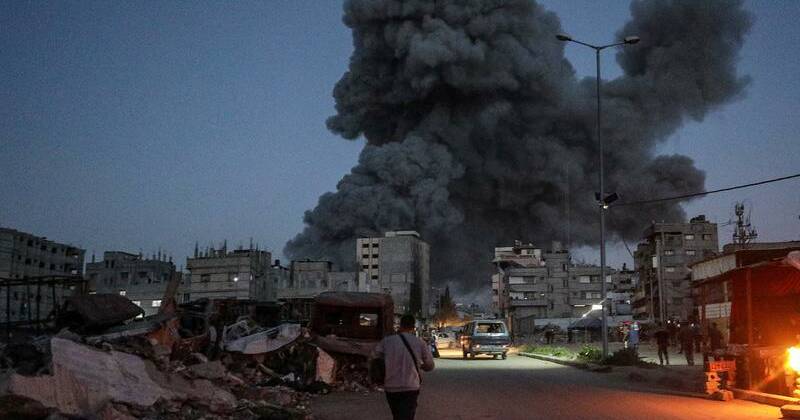Hundreds of thousands of Gazans fled seeking shelter. This is one of the biggest mass displacements of the war. Israeli forces advanced into the ruins of Rafah. This city is part of a newly announced “security zone” they intend to seize.
A day prior, Israel declared their intention to capture large swathes of the crowded enclave. Israeli forces then pushed into Rafah, on Gaza’s southern edge. It had served as a last refuge for people fleeing other areas for much of the war.
Casualties and Airstrikes
Gaza’s health ministry reported at least 97 people died in Israeli strikes in the past 24 hours. An airstrike around dawn in Shejaia, a suburb of Gaza City in the north, killed at least 20.
Later, an Israeli airstrike killed at least 27 Palestinians, including women and children. This occurred inside a school building that sheltered displaced families in Gaza City, local health authorities said. The Israeli military stated the attack hit key Palestinian “terrorists.”
Medics said three missiles slammed into the Dar Al-Arqam school building in Tuffah neighbourhood in Gaza City. The Israeli military claimed it struck a command centre. Militants had used the centre to plan and execute attacks against Israeli civilians and army troops.
The Situation in Rafah and Khan Younis
Rafah “is gone, it is being wiped out,” a father of seven, who fled from Rafah to Khan Younis, told Reuters.
“They are knocking down what is left standing of houses and property,” said the man, who declined to be identified for fear of repercussions.
The assault to capture Rafah is a major escalation in the war. Israel restarted the war last month after effectively abandoning a ceasefire in place since January.
In Shejaia in the north, one of the districts where Israel has ordered the population to leave, hundreds of residents streamed out on Thursday. Some carried their belongings as they walked. Others used donkey carts, bikes, or vans.
“I want to die. Let them kill us and free us from this life. We’re not living, we’re dead,” said Umm Aaed Bardaa.
In Khan Younis, a strike killed several people. Adel Abu Fakher was checking the damage to his tent. “There’s nothing left for us. We’re being killed while asleep,” he said.
Fears of Depopulation and Blockade
Israel has not spelled out its long-term aims for the security zone its troops are now seizing. Prime Minister Benjamin Netanyahu said troops were taking an area he called the “Morag Axis.” He referenced an abandoned former Israeli settlement between Rafah and Khan Younis.
Gazans who had returned to homes in the ruins during the ceasefire have now been ordered to flee communities. These communities are on the northern and southern edges of the strip.
They fear Israel intends to depopulate those areas indefinitely. This would leave many hundreds of thousands of people permanently homeless, while Israel seizes some of Gaza’s last agricultural land and critical water infrastructure.
Since the first phase of the ceasefire expired at the start of March, Israel has imposed a total blockade on all goods for Gaza’s 2.3 million residents. This is recreating what international organisations call a humanitarian catastrophe.
Investigations and Stated Goals
Israel’s military said it was conducting an investigation into the deaths of 15 Palestinian aid workers. They were found buried in a shallow grave in March near Red Crescent vehicles. This incident caused global alarm. The military said troops fired on the cars. They believed they carried fighters.
Israel’s stated goal since the start of the war has been the destruction of Hamas. Hamas ran Gaza for nearly two decades.
However, no effort has been made to establish an alternative administration. Hamas returned to control during the ceasefire. Fighters still hold 59 dead and living hostages. Israel says Hamas must hand them over to extend the truce temporarily. Hamas says it will free them only under a deal that permanently ends the war.
Israeli leaders say they have been encouraged by signs of protest in Gaza against Hamas. Hundreds of people demonstrated in north Gaza’s Beit Lahiya on Wednesday. Hamas calls the protesters collaborators and says Israel is behind them.
The war began with a Hamas attack on Israeli communities on October 7, 2023. Gunmen killed 1,200 people and took more than 250 hostages, according to Israeli tallies. Israel’s campaign has so far killed more than 50,000 Palestinians, Gaza health authorities say.
Rafah residents said most of the local population had followed Israel’s order to leave. Israeli strikes toppled buildings there. However, a strike on the main road between Khan Younis and Rafah stopped most movement between the two cities.
Bombardment also limited the movement of people and traffic along the western coastal road near Morag. “Others stayed because they don’t know where to go, or got fed up of being displaced several times. We are afraid they might be killed or at best detained,” said Basem, a resident of Rafah. He declined to give a second name.
Click here for more World news.


